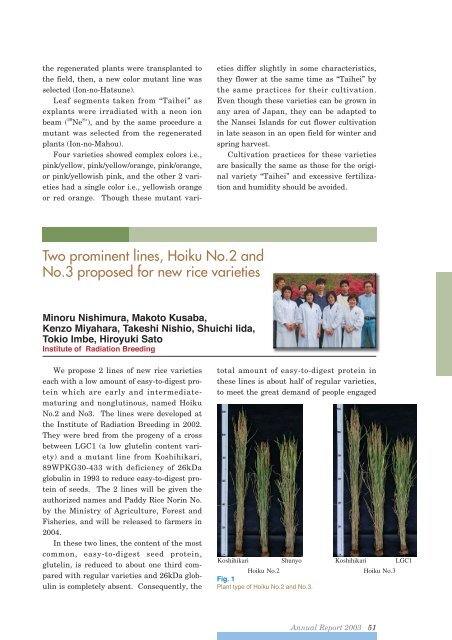Create successful ePaper yourself
Turn your PDF publications into a flip-book with our unique Google optimized e-Paper software.
the regenerated plants were transplanted tothe field, then, a new color mutant line wasselected (Ion-no-Hatsune).Leaf segments taken from “Taihei” asexplants were irradiated with a neon ionbeam ( 20 Ne 8+ ), and by the same procedure amutant was selected from the regeneratedplants (Ion-no-Mahou).Four varieties showed complex colors i.e.,pink/yellow, pink/yellow/orange, pink/orange,or pink/yellowish pink, and the other 2 varietieshad a single color i.e., yellowish orangeor red orange. Though these mutant varietiesdiffer slightly in some characteristics,they flower at the same time as “Taihei” bythe same practices for their cultivation.Even though these varieties can be grown inany area of Japan, they can be adapted tothe Nansei Islands for cut flower cultivationin late season in an open field for winter andspring harvest.Cultivation practices for these varietiesare basically the same as those for the originalvariety “Taihei” and excessive fertilizationand humidity should be avoided.Two prominent lines, Hoiku No.2 andNo.3 proposed for new rice varietiesMinoru Nishimura, Makoto Kusaba,Kenzo Miyahara, Takeshi Nishio, Shuichi Iida,Tokio Imbe, Hiroyuki SatoInstitute of Radiation BreedingWe propose 2 lines of new rice varietieseach with a low amount of easy-to-digest proteinwhich are early and intermediatematuringand nonglutinous, named HoikuNo.2 and No3. The lines were developed atthe Institute of Radiation Breeding in 2002.They were bred from the progeny of a crossbetween LGC1 (a low glutelin content variety)and a mutant line from Koshihikari,89WPKG30-433 with deficiency of 26kDaglobulin in 1993 to reduce easy-to-digest proteinof seeds. The 2 lines will be given theauthorized names and Paddy Rice Norin No.by the Ministry of Agriculture, Forest andFisheries, and will be released to farmers in2004.In these two lines, the content of the mostcommon, easy-to-digest seed protein,glutelin, is reduced to about one third comparedwith regular varieties and 26kDa globulinis completely absent. Consequently, thetotal amount of easy-to-digest protein inthese lines is about half of regular varieties,to meet the great demand of people engagedFig. 1Plant type of Hoiku No.2 and No.3.<strong>Annual</strong> <strong>Report</strong> <strong>2003</strong> 51













